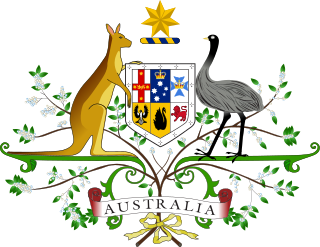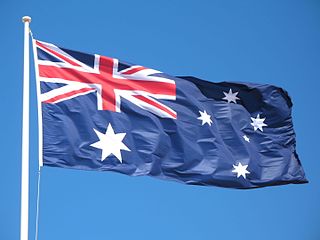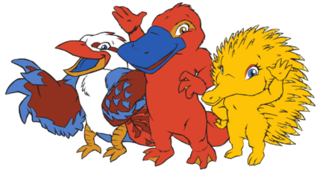 W
WThe culture of Australia is primarily a Western culture, derived from Britain but also influenced by the unique geography of Australia, the cultural input of Aboriginal, Torres Strait Islander and other Australian people. The British colonization of Australia began in 1788, and waves of multi-ethnic migration followed. Evidence of a significant Anglo-Celtic heritage includes the predominance of the English language, the existence of a democratic system of government drawing upon the British traditions of Westminster Government, Parliamentarianism and constitutional monarchy, American constitutionalist and federalist traditions, Christianity as the dominant religion, and the popularity of sports originating in the British Isles.
 W
WArt in Australia was an Australian magazine that was published between 1916 and 1942. The founders were Sydney Ure Smith and Bertram Stevens. It was published by Angus & Robertson in 1917–1918, Art in Australia Ltd in the years 1918–1934, and in the final decade (1934–1942) was published by the Sydney Morning Herald.
 W
WThe Australian Journal of Linguistics is a quarterly peer-reviewed academic journal in the field of linguistics established in 1981. It is the official journal of the Australian Linguistic Society and is published by Routledge. Its main focus is theoretical linguistics, as well as matters pertaining particularly to Australia such as Australian English and its indigenous languages. The current editors are Keith Allan and Jean Mulder.
 W
WAustralian nationalism asserts that the Australians are a nation and promotes the national and cultural unity of Australia. Australian nationalism has a history dating back to the late 19th century as Australia gradually developed a distinct culture and identity from that of Britain, beginning to view itself as a unique and separate entity and not simply an extension or a derivation of British culture and identity.
 W
WAustralian rules football culture is the cultural aspects surrounding the game of Australian rules football, particular to Australia and the areas where it is most popular. This article explores aspects and issues surrounding the game, as well as the players, and society. Australian Rules is a sport rich in tradition and Australian cultural references, especially surrounding the rituals of gameday for players, officials, and supporters.
 W
WAustraliana includes the items, people, places, flora, fauna and events of Australian origins. Anything pertaining to Australian culture, society, geography and ecology can fall under the term Australiana, especially if it is endemic to Australia. Australiana often borrows from Australian Aboriginal culture, or the stereotypical Australian culture of the early 1900s.
 W
WAn Australophile is one who appreciates or expresses love of Australian culture, the Australian people, Australian history or all things Australian in general. An Australophile may extend to someone who is born outside Australia and the definition is not limited to an Australian itself. The concept of Australophilia or Ozophilia is opposed to Australophobia, which is the dislike or fear of Australia and its cultural aspects.
 W
WThe Australian expression 'black stump' is the name for an imaginary point beyond which the country is considered remote or uncivilised, an abstract marker of the limits of established settlement. The origin of the expression, especially in its evolved use as an imaginary marker in the landscape, is contested. The various claims are discussed below.
 W
WChris was a Merino ram who gained international fame in September 2015 after being shorn of a record amount of wool in Canberra, Australia. Chris was named after a sheep character in the sitcom Father Ted by local Bonner resident Sue Dowling, who spotted the sheep wandering in a paddock near the Bonner district in Canberra.
 W
WFrom 1827, Mechanics' Institutes, Literary Institutes, Athenaeums and Schools of Arts played an important role in the life of early Australian communities. Among their roles was the provision of libraries and reading rooms, but as community institutions they also provided lectures and adult education.
 W
W"For the Fallen" is a poem written by Laurence Binyon. It was first published in The Times in September 1914.
 W
WFuneral celebrant is a formal term denoting members of a group of non-clergy professionals who organise funeral ceremonies, which are not closely linked to any religion or to belief in an after-life. The concept of funeral celebrants is analogous in Western countries to that of civil celebrants. Civil celebrant funerals began in Australia in 1975. On 19 July 1973 the Australian Attorney-General Lionel Murphy had appointed civil marriage celebrants with the aim of creating ceremonies of substance and meaning for non-church people. As secular (civil) marriage ceremonies became accepted, first in Australia and then in other Western countries such as New Zealand, and much later in the United States of America it was inevitable that a similar philosophical paradigm would be applied to secular funerals.
 W
WHome ownership in Australia is considered a key cultural icon, and part of the Australian tradition known as the Great Australian Dream of "owning a detached house on a fenced block of land." Home ownership has been seen as creating a responsible citizenry; according to a former Premier of Victoria: "The home owner feels that he has a stake in the country, and that he has something worth working for, living for, fighting for."
 W
WKangaroos, Wallabys and other Macropodidae have become emblems and symbols of Australia, as well as appearing in popular culture both internationally and within Australia itself.
 W
WKoala emblems and popular culture deals with the uses which have been made of the image of the Koala, such as coins, emblems, logos, mascots and in the naming of sports teams.
 W
WAustralia has no official language. However, English has been entrenched as the de facto national language since European settlement. Australian English is a major variety of the language with a distinctive pronunciation and lexicon, and differs slightly from other varieties of English in grammar and spelling. General Australian serves as the standard dialect.
 W
WDrisana Levitzke-Gray is an Australian disability rights campaigner from Perth, Western Australia. She is an advocate for deaf culture, and a native speaker of Auslan. In 2015, she was the Young Australian of the Year.
 W
WMainland Australia is the main landmass of the Australian continent, excluding Tasmania and other offshore islands. The landmass also constitutes the mainland of the territory governed by the Commonwealth of Australia, and the term, along with continental Australia, can be used in a geographic sense to exclude surrounding continental islands and external territories. Generally, the term is applied to the states of New South Wales, Queensland, South Australia, Victoria, and Western Australia, as well as the Australian Capital Territory, Jervis Bay Territory, and Northern Territory.
 W
WMateship is an Australian cultural idiom that embodies equality, loyalty and friendship. Russel Ward, in The Australian Legend (1958), saw the concept as a central one to the Australian people. Mateship derives from mate, meaning friend, commonly used in Australia as an amicable form of address.
 W
W"Not happy, Jan!" was a line delivered by comedian Deborah Kennedy in an Australian television advertisement from the year 2000. Due to the ad's popularity in Australia, the line entered the cultural vernacular as a catch phrase used to express a feeling of discontent.
 W
WOlly, Syd and Millie were the official mascots of the 2000 Summer Olympics and Lizzie was the official mascot of the 2000 Summer Paralympics, both held in Sydney, Australia.
 W
WThe punk subculture includes a diverse and widely known array of ideologies, fashion, and other forms of expression, visual art, dance, literature and film. It is largely characterised by anti-establishment views, the promotion of individual freedom, DIY ethics, and is centred on a loud, aggressive genre of rock music called punk rock.
 W
WSheep farming or sheep husbandry is the raising and breeding of domestic sheep. It is a branch of animal husbandry. Sheep are raised principally for their meat, milk, and fiber (wool). They also yield sheepskin and parchment.
 W
WSheep shearing is the process by which the woollen fleece of a sheep is cut off. The person who removes the sheep's wool is called a shearer. Typically each adult sheep is shorn once each year. The annual shearing most often occurs in a shearing shed, a facility especially designed to process often hundreds and sometimes more than 3,000 sheep per day.
 W
WA showbag is a themed bag of commercial products and promotional merchandise, made available for purchase. It is a distinctive feature of Australian agricultural shows, where they are sold from stalls. The bag is usually made from plastic or heavy paper, and is printed with graphics promoting the theme or brand. Showbags are unique to Australia.
 W
WSquatting is an historical Australian term that referred to someone who occupied a large tract of Aboriginal land in order to graze livestock. Initially often having no legal rights to the land, squatters became recognised by the colonial government as owning the land by being the first European settlers in the area. Eventually, the term "squattocracy", a play on "aristocracy", came into usage to refer to squatters and the social and political power they possessed.
 W
WTea consumption is an essential part of the Australian culture. Small quantities of tea are grown and produced in Australia itself.